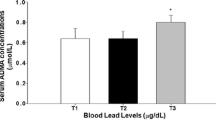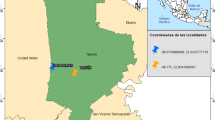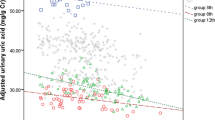Abstract
The aim of the present study was to evaluate possible effects of endothelial nitric oxide synthase (eNOS) polymorphisms on systolic (SBP) and diastolic blood pressure (DBP) and on nitrite levels in plasma (NitP) in a population coexposed to methylhemoglobin (MeHg) and lead (Pb) in the Amazonian region, Brazil. Plasmatic levels of hemoglobin Hg (HgP) and Pb (PbP) were determined by inductively coupled plasma-mass spectrometry, whereas NitP were quantified by chemiluminescence. Genotyping was performed by conventional and restriction fragment length polymorphism–polymerase chain reaction assay. The population age ranged from 18 to 87 years (mean 40 ± 16), and the distribution between the sexes was homogenous (63 men and 50 women). Mean HgP and PbP were 7.1 ± 6.1 and 1.1 ± 1.1 µg L−1, respectively. PbP was correlated to SBP and DBP, whereas no effects were observed for HgP on blood pressure. Subjects carrying the 4b allele in intron 4 presented greater SBP and DBP compared with those who had the 4a4a genotype. In addition, interactions between alcohol consumption and the −786 T/C polymorphism were observed on NitP, i.e., individuals carrying the polymorphic allele and drinkers had lower NitP. Taken together, our data give new insights concerning the genetic effects of eNOS polymorphisms on biomarkers related to cardiovascular status in populations coexposed to Hg and Pb.

Similar content being viewed by others
References
Agency for Toxic Substances and Disease Registry (2007) Toxicological profile for lead. Department of Health and Human Services, Public Health Service, Atlanta
Barbosa F Jr, Sertorio JT, Gerlach RF, Tanus-Santos JE (2006) Clinical evidence for lead-induced inhibition of nitric oxide formation. Arch Toxicol 80:811–816
Barbosa F Jr, Fillion M, Lemire M, Passos CJ, Rodrigues JL, Philibert A et al (2009) Elevated blood lead levels in a riverside population in the Brazilian Amazon. Environ Res 109:594–599
Barcelos GRM, De Marco KC, Grotto D, Valentini J, Garcia SC, Braga GUL et al (2012) Evaluation of glutathione-S-transferase GSTM1 and GSTT1 polymorphisms and methylmercury metabolism in an exposed Amazonian population. J Toxicol Environ Health A 75:960–970
Barcelos GRM, Grotto D, De Marco KC, Valentini J, Lengert AH, Oliveira AAS et al (2013) Polymorphisms in glutathione-related genes modify mercury concentrations and antioxidant status in subjects environmentally exposed to methylmercury. Sci Total Environ 463–464:319–325
Beckett WS, Nordberg GF, Clarkson TW (2007) Routes of exposure, dose, and metabolism of metals. In: Nordberg GF, Fowler B, Nordberg M, Friberg LT (eds) Handbook on the toxicology of metals, 3rd edn. Academic Press, San Diego, pp 39–64
Briasoulis A, Agarwal V, Messerli FH (2012) Alcohol consumption and the risk of hypertension in men and women: a systematic review and meta-analysis. J Clin Hypertens 14:792–798
Bridges CC, Zalups KR (2010) Transport of inorganic mercury and methylmercury in target tissues and organs. J Toxicol Environ Health B 13:385–410
Carneiro MFH, Evangelista FS, Barbosa F Jr (2013) Manioc flour consumption as a risk factor for lead poisoning in the Brazilian Amazon. J Toxicol Environ Health A 76:206–216
Casas JP, Cavalleri GL, Bautista LE, Smeeth L, Humphries SE, Hingorani AD (2006) Endothelial nitric oxide synthase gene polymorphisms and cardiovascular disease: a HuGE review. Am J Epidemiol 164:921–935
Çengel A, Sahinarslan A (2006) Nitric oxide and cardiovascular system. Anadolu Kardiyol Derg 6:364–368
Choi AL, Weihe P, Budtz-Jorgensen E, Jorgensen PJ, Salonen JT, Tuomainen TP et al (2009) Methylmercury exposure and adverse cardiovascular effects in Faroese whaling men. Environ Health Perspect 17:367–372
Clarkson TW, Magos L (2006) The toxicology of mercury and its chemical compounds. Crit Rev Toxicol 36:609–662
Clarkson TW, Vyas JB, Ballatori N (2007) Mechanisms of mercury disposition in the body. Am J Ind Med 50:757–764
Coelho P, Costa S, Silva S, Walter A, Ranville J, Sousa AC et al (2012) Metal(loid) levels in biological matrices from human populations exposed to mining contamination—Panasqueira Mine (Portugal). J Toxicol Environ Health A 75:893–908
De Marco KC, Braga GU, Barbosa F Jr (2011) Determination of the effects of eNOS gene polymorphisms (T-786C and Glu298Asp) on nitric oxide levels in a methylmercury-exposed population. J Toxicol Environ Health A 74:1323–1333
De Marco KC, Antunes LMG, Tanus-Santos JE, Barbosa F Jr (2012) Intron 4 polymorphism of the endothelial nitric oxide synthase (eNOS) gene is associated with decreased NO production in a mercury-exposed population. Sci Total Environ 414:708–712
Dosenko VE, Zagoriy VY, Haytovich NV, Gordok OA, Moibenko AA (2006) Allelic polymorphism of endothelial NO synthase gene and its functional manifestations. Acta Biochim Pol 53:299–302
Flora G, Gupta D, Tiwari A (2012) Toxicity of lead: a review with recent updates. Interdiscip Toxicol 5:47–58
Garcia-Arenas G, Claudio L, Perez-Severiano F, Rios C (1999) Lead acetate exposure inhibits nitric oxide synthase activity in capillary and synaptosomal fractions of mouse brain. Toxicol Sci 50:244–248
García-Lestón J, Roma-Torres J, Mayan O, Schroecksnadel S, Fuchs D, Moreira AO et al (2012) Assessment of immunotoxicity parameters in individuals occupationally exposed to lead. J Toxicol Environ Health A 75:807–818
Ghilardi G, Biondi ML, DeMonti M, Bernini M, Turri O, Massaro F et al (2002) Independent risk factor for moderate to severe internal carotid artery stenosis: T786C mutation of the endothelial nitric oxide synthase gene. Clin Chem 48:989–993
Grotto D, de Castro MM, Barcelos GRM, Garcia SC, Barbosa F Jr (2009) Low level and sub-chronic exposure to methylmercury induces hypertension in rats: Nitric oxide depletion and oxidative damage as possible mechanisms. Arch Toxicol 83:653–662
Guallar E, Sanz-Gallardo MI, Van’t Veer P, Bode P, Aro A, Gómez-Aracena J et al (2002) Mercury, fish oils, and the risk of myocardial infarction. N Engl J Med 347:1747–1754
Hingorani AD (2003) Endothelial nitric oxide synthase polymorphisms and hypertension. Curr Hypertens Rep 5:19–25
Karagas MR, Choi AL, Oken E, Horvat M, Schoeny R, Kamai E et al (2012) Evidence on the human health effects of low-level methylmercury exposure. Environ Health Perspect 120:799–806
Khalil-Manesh F, Gonick HC, Weiler EW, Prins B, Weber MA, Purdy RE (1993) Lead-induced hypertension: possible role of endothelial factors. Am J Hypertens 6:723–729
Koliaki C, Katsilambros N (2013) Dietary sodium, potassium, and alcohol: key players in the pathophysiology, prevention, and treatment of human hypertension. Nut Rev 71:402–411
Levy AS, Chung JC, Kroetsch JT, Rush JW (2009) Nitric oxide and coronary vascular endothelium adaptations in hypertension. Vasc Health Risk Manag 5:1075–1087
Lorscheider FL, Vimy MJ, Summers AO (1995) Mercury exposure from ‘silver’ tooth fillings: Emerging evidence questions a traditional dental paradigm. FASEB J 9:504–508 letter and response 1499–1500
Mangiapane H (2012) Cardiovascular disease and diabetes. Adv Exp Med Biol 771:219–228
Miao X, Lv H, Wang B, Chen Q, Miao L, Su G et al (2013) Deletion of angiotensin II type 1 receptor gene attenuates chronic alcohol-induced retinal ganglion cell death with preservation of VEGF expression. Curr Eye Res 38:185–193
Mozaffarian D (2009) Fish, mercury, selenium and cardiovascular risk: current evidence and unanswered questions. Int J Environ Res Public Health 6:1894–1916
National Toxicology Program (2012) NTP Monograph on health effects of low-level lead. US Department of Health and Human Services. Available at http://ntp.niehs.nih.gov/ntp/ohat/lead/final/monographhealtheffectslowlevellead_newissn_508.pdf
Nava-Ruiz C, Méndez-Armenta M, Ríos C (2012) Lead neurotoxicity: effects on brain nitric oxide synthase. J Mol Histol 43:553–563
Navas-Ancien A, Guallar E, Silbergeld EK, Rothenberg SJ (2007) Lead exposure and cardiovascular disease—a systematic review. Environ Health Perspect 115:472–482
O’flaherty EJ (1998) Physiologically based models of metal kinetics. Crit Rev Toxicol 28:271–317
Oliveira AAS, Souza MF, Lengert AH, Oliveira MT, Camargo RBOG, Braga GUL et al (2014) Genetic polymorphisms in glutathione (GSH)-related genes affect the plasmatic Hg/whole blood Hg partitioning and the distribution between inorganic and methylmercury levels in plasma collected from a fish eating population. Biomed Res Int. doi:10.1155/2014/940952
Passos CJ, Mergler D, Fillion M, Lemire M, Mertens F, Guimaraes JR et al (2007) Epidemiologic confirmation that fruit consumption influences mercury exposure in riparian communities in the Brazilian Amazon. Environ Res 105:183–193
Poręba R, Gać P, Poręba M, Andrzejak R (2011) Environmental and occupational exposure to lead as a potential risk factor for cardiovascular disease. Environ Toxicol Pharmacol 31:267–277
Reiter CD, Wang X, Tanus-Santos JE, Hogg N, Cannon RO 3rd et al (2002) Cell-free hemoglobin limits nitric oxide bioavailability in sickle-cell disease. Nat Med 8:1383–1389
Roman HA, Walsh TL, Coull BA, Dewailly É, Guallar E, Hattis D et al (2011) Evaluation of the cardiovascular effects of methylmercury exposures: current evidence supports development of a dose-response function for regulatory benefits analysis. Environ Health Perspect 119:607–614
Saini V, Bhatnagar MK, Bhattacharjee J (2012) Endothelial nitric oxide synthase Glu298Asp (G894T) gene polymorphism in coronary artery disease patients with type 2 diabetes mellitus. Diabetes Metab Syndr 6:106–109
Salonen JT, Seppänen K, Nyyssönen K, Korpela H, Kauhanen J, Kantola M et al (1995) Intake of mercury from fish, lipid peroxidation, and the risk of myocardial infarction and coronary, cardiovascular, and any death in eastern Finnish men. Circulation 91:645–655
Salonen JT, Seppänen K, Lakka TA, Salonen R, Kaplan GA (2000) Mercury accumulation and accelerated progression of carotid atherosclerosis: a population based prospective 4-year follow-up study in men in eastern Finland. Atherosclerosis 148:265–273
Schutz A, Bergdahl IA, Ekholm A, Skerfving S (1996) Measurement by ICP-MS of lead in plasma and whole blood of lead workers and controls. Occup Environ Med 53:736–740
Solenkova NV, Newman JD, Berger JS, Thurston G, Hochman JS, Lamas GA (2014) Metal pollutants and cardiovascular disease: mechanisms and consequences of exposure. Am Heart J 168:812–822
Souza SS, Campiglia AD, Barbosa F Jr (2013) A simple method for methylmercury, inorganic mercury and ethylmercury determination in plasma samples by high performance liquid chromatography-cold-vapor-inductively coupled plasma mass spectrometry. Anal Chim Acta 761:11–17
Tanus-Santos JE, Desai M, Flockhart DA (2001) Effects of ethnicity on the distribution of clinically relevant endothelial nitric oxide variants. Pharmacogenetics 11:719–725
Vaziri ND, Liang K, Ding Y (1999) Increased nitric oxide inactivation by reactive oxygen species in lead-induced hypertension. Kidney Int 56:1492–1498
Virtanen JK, Voutilainen S, Rissanen TH, Mursu J, Tuomainen TP, Korhonen MJ et al (2005) Mercury, fish oils, and risk of acute coronary events and cardiovascular disease, coronary heart disease, and all-cause mortality in men in eastern Finland. Arterioscler Thromb Vasc Biol 25:228–233
Wang J, Dudley D, Wang XL (2002) Haplotype specific effects on endothelial nitric oxide synthase promoter efficiency: Modifiable by cigarette smoking. Arterioscler Thromb Vasc Biol 22:1–4
Zhang LF, Peng SQ, Wang S, Li BL, Han G, Dong YS (2007) Direct effects of lead (Pb2+) on the relaxation of in vitro cultured rat aorta to acetylcholine. Toxicol Lett 170:104–110
Zota AR, Shenassa ED, Morello-Frosch R (2013) Allostatic load amplifies the effect of blood lead levels on elevated blood pressure among middle-aged U.S. adults: a cross-sectional study. Environ Health 12:64
Acknowledgments
We thank the São Paulo Research Foundation (FAPESP, 2007/00054-2; 2010/16691-4; 2011/22575-0), the National Council for Technological and Scientific Development (CNPq), and Coordination for the Improvement of Higher Education Personnel (CAPES) for financial support.
Author information
Authors and Affiliations
Corresponding author
Rights and permissions
About this article
Cite this article
Barcelos, G.R.M., De Marco, K.C., de Rezende, V.B. et al. Genetic Effects of eNOS Polymorphisms on Biomarkers Related to Cardiovascular Status in a Population Coexposed to Methylmercury and Lead. Arch Environ Contam Toxicol 69, 173–180 (2015). https://doi.org/10.1007/s00244-015-0137-8
Received:
Accepted:
Published:
Issue Date:
DOI: https://doi.org/10.1007/s00244-015-0137-8




